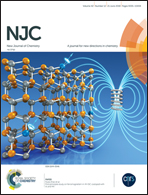β-Carboline–imidazopyridine hybrids: selective and sensitive optical sensors for copper and fluoride ions†
Abstract
Two rationally designed β-carboline–imidazopyridine hybrid chromofluorescent sensors S1 and S2 have been successfully synthesized and evaluated for the selective sensing of metal ions and anions. The synthesized sensors selectively sense copper ions through a significant color change from colorless to yellow along with a shift in their absorption spectra and enhancement in their emission intensities to ‘turn on’ the fluorescence mode in preference to other metal ions. Moreover, sensors S1 and S2 also recognize fluoride ions via H-bond interaction and subsequent deprotonation to elicit a color change from colorless to yellow conspicuous to the naked eye. Detailed UV-visible analyses revealed that the sensors interact with copper ions in a 1 : 1 binding stoichiometry with a detection range of 10−7 M. In addition, competing binding studies by UV-visible analyses revealed that the sensors exhibit more selectivity toward copper ions in comparison to fluoride ions. These experimental results were further corroborated by DFT (Density Functional Theory) calculations.



 Please wait while we load your content...
Please wait while we load your content...